Intel P965: Mid-Range Performance Sector Roundup
by Gary Key on October 20, 2006 9:00 PM EST- Posted in
- Motherboards
Gaming Performance- FPS
As usual, gaming performance was tested with a variety of current games. We ran benchmarks with our standard 1280x1024 resolution. Given the number of users that run 19 inch LCDs these days, 1280x1024 represents one of the most commonly used resolutions. We will show 1600x1200 4xAA/8xAF and 1920x1200 4xAA/8XAF results in part three of our roundup when we test the motherboards that are capable of running CrossFire.
Battlefield 2
This benchmark is performed using DICE's built-in demo playback functionality with additional capture capabilities designed in house. During the benchmark, the camera switches between players and vehicles in order to capture the most action possible. There is a significant amount of smoke, explosions, and vehicle usage as this a very GPU intensive Battlefield 2 benchmark. We run Battlefield 2 using the highest quality graphics settings available in the video settings. The game itself is best experienced with average in-game frame rates of 35 and up.
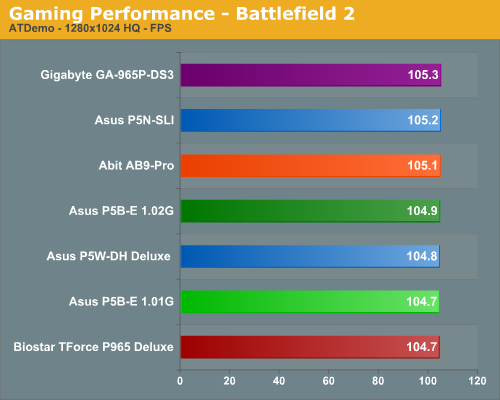
F.E.A.R.
F.E.A.R. uses a built-in performance test that generates graphical test scenes based upon the actual game engine. This test consists of a couple of different action sequences, a stressful water flyby, and heavy use of shadows while traveling through hallways. F.E.A.R. is a very graphics intensive game and we switch all settings to maximum. An average frame rate for F.E.A.R. that can dip into the teens is not good for a first person shooter, but the game is still playable to around 25 fps, although we prefer 35fps.
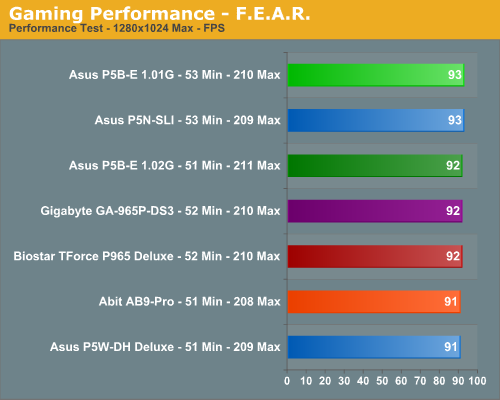
Half-Life 2: Lost Coast
We use the built-in timedemo feature to benchmark the game. Our timedemo consists of starting at the bottom of the hill near the lake and ending in the old church. The Source engine timedemo feature is similar to the nettimedemo of Id's Doom 3 engine, in that it plays back more than just the graphics. The highest visual quality settings possible were used with HDR turned on. While the Source engine is notorious for giving great frame rates for almost any hardware setup, we find the game isn't as enjoyable if it isn't running at 35fps or above.
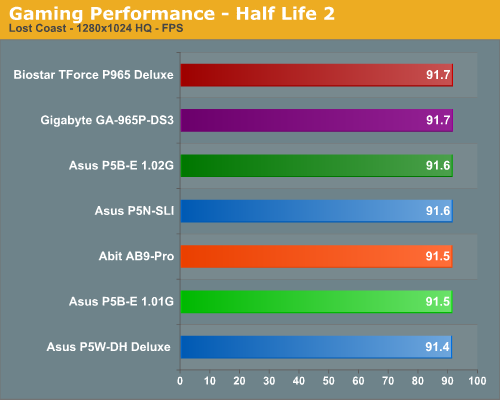
Quake 4
There has always been a lot of debate in the community surrounding pure timedemo benchmarking. We have opted to stick with the nettimedemo test rather than the timedemo option for motherboard benchmarking of Quake 4. To be clear, this means our test results focus mostly on the performance one would experience during actual game play. Additionally, Quake 4 limits frame rate to 60 fps during gameplay whether or not VSync is enabled. Our benchmark utilizes the IdNetDemo. This demo includes mainly outdoor areas with numerous players trying to wipe each other out. We tested the game with High Quality settings (uncompressed normal maps), and we enabled all the advanced graphics options except for VSync.
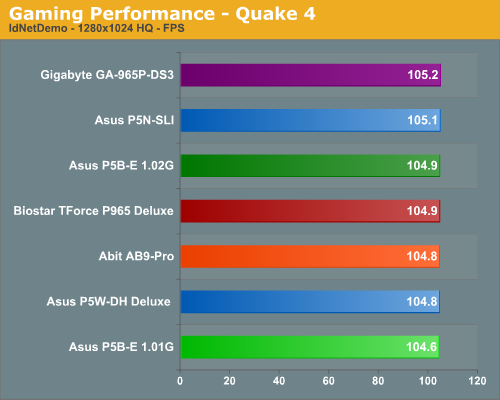
Serious Sam II
This benchmark is performed using Croteam's built-in demo capability in the Serious Sam II engine. We utilize the included Branchester Demo and capture the playback results using the Ctrl-~ function. The benchmark features a large number of combatants, explosions, and general mayhem. The benchmark is primarily GPU sensitive with the actual percentage of GPU/CPU/Audio activity being displayed during the benchmark run. We typically find this game is very playable at average in-game rates of 60 and above. We maximize all settings except antialiasing and anisotropic filtering within the general and advanced video settings.
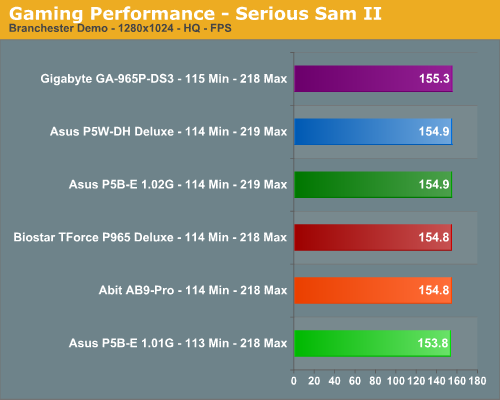
FPS Gaming Summary
Our test results basically speak for themselves. If you utilize the same chipset you can expect the same results during benchmark testing. The differences between each board are minor and during actual game play we could not tell any differences amongst the motherboards tested today. We did not experience any issues during testing or during game play with each board. We generally play games for a couple of hours with each board to ensure there are no issues such as overheating, stuttering, or network issues when playing on-line. The one result that did catch our eye is that the performance of the Gigabyte GA-965P-DS3 was very consistent throughout testing as the board scored near or at the top in every game. We attribute this to Gigabyte programming in slightly tighter memory and MCH timings than the other manufacturers. Of course this is affecting their overclocking capability at this time.
As usual, gaming performance was tested with a variety of current games. We ran benchmarks with our standard 1280x1024 resolution. Given the number of users that run 19 inch LCDs these days, 1280x1024 represents one of the most commonly used resolutions. We will show 1600x1200 4xAA/8xAF and 1920x1200 4xAA/8XAF results in part three of our roundup when we test the motherboards that are capable of running CrossFire.
Battlefield 2
This benchmark is performed using DICE's built-in demo playback functionality with additional capture capabilities designed in house. During the benchmark, the camera switches between players and vehicles in order to capture the most action possible. There is a significant amount of smoke, explosions, and vehicle usage as this a very GPU intensive Battlefield 2 benchmark. We run Battlefield 2 using the highest quality graphics settings available in the video settings. The game itself is best experienced with average in-game frame rates of 35 and up.

F.E.A.R.
F.E.A.R. uses a built-in performance test that generates graphical test scenes based upon the actual game engine. This test consists of a couple of different action sequences, a stressful water flyby, and heavy use of shadows while traveling through hallways. F.E.A.R. is a very graphics intensive game and we switch all settings to maximum. An average frame rate for F.E.A.R. that can dip into the teens is not good for a first person shooter, but the game is still playable to around 25 fps, although we prefer 35fps.

Half-Life 2: Lost Coast
We use the built-in timedemo feature to benchmark the game. Our timedemo consists of starting at the bottom of the hill near the lake and ending in the old church. The Source engine timedemo feature is similar to the nettimedemo of Id's Doom 3 engine, in that it plays back more than just the graphics. The highest visual quality settings possible were used with HDR turned on. While the Source engine is notorious for giving great frame rates for almost any hardware setup, we find the game isn't as enjoyable if it isn't running at 35fps or above.

Quake 4
There has always been a lot of debate in the community surrounding pure timedemo benchmarking. We have opted to stick with the nettimedemo test rather than the timedemo option for motherboard benchmarking of Quake 4. To be clear, this means our test results focus mostly on the performance one would experience during actual game play. Additionally, Quake 4 limits frame rate to 60 fps during gameplay whether or not VSync is enabled. Our benchmark utilizes the IdNetDemo. This demo includes mainly outdoor areas with numerous players trying to wipe each other out. We tested the game with High Quality settings (uncompressed normal maps), and we enabled all the advanced graphics options except for VSync.

Serious Sam II
This benchmark is performed using Croteam's built-in demo capability in the Serious Sam II engine. We utilize the included Branchester Demo and capture the playback results using the Ctrl-~ function. The benchmark features a large number of combatants, explosions, and general mayhem. The benchmark is primarily GPU sensitive with the actual percentage of GPU/CPU/Audio activity being displayed during the benchmark run. We typically find this game is very playable at average in-game rates of 60 and above. We maximize all settings except antialiasing and anisotropic filtering within the general and advanced video settings.

FPS Gaming Summary
Our test results basically speak for themselves. If you utilize the same chipset you can expect the same results during benchmark testing. The differences between each board are minor and during actual game play we could not tell any differences amongst the motherboards tested today. We did not experience any issues during testing or during game play with each board. We generally play games for a couple of hours with each board to ensure there are no issues such as overheating, stuttering, or network issues when playing on-line. The one result that did catch our eye is that the performance of the Gigabyte GA-965P-DS3 was very consistent throughout testing as the board scored near or at the top in every game. We attribute this to Gigabyte programming in slightly tighter memory and MCH timings than the other manufacturers. Of course this is affecting their overclocking capability at this time.










62 Comments
View All Comments
vailr - Saturday, October 21, 2006 - link
Re:So, how about the (yet unreleased) ATI and NVidia Conroe chipset boards?
Does either chipset include PATA support?
Thanks.
Gary Key - Saturday, October 21, 2006 - link
They both have native support for two drives.
n7 - Saturday, October 21, 2006 - link
Gary, always love your reviews!I read thru the whole thing, & it was a good read :)
Meticulous detail, as well great sarcastic humor as well.
I look forward to the following parts.
Sho - Friday, October 20, 2006 - link
In an earlier AnandTech article, the one about Kentsfield support, it was written that Gigabyte would bring a revision 2.0 of all of their P965 boards to the market in mid-October, including the DS3. The article does not mention whether the board tested was this new rev 2,9 or any other. Could that be clarified?And does anybody know what was changed/fixed in 2.0?
Gary Key - Friday, October 20, 2006 - link
Gigabyte has not released any further details on the revision 2 boards except for the fact they were addressing some layout issues and possible BIOS improvements. The only major change we could see them making would be going from a three phase power design on the DS3 to a five phase system as an example. The board we tested is still revision 1.Sho - Saturday, October 21, 2006 - link
Thanks!dreddly - Friday, October 20, 2006 - link
'caliper' should be caliber on AB9Pro pageGreat work on this roundup though, impressive job.
Puddyglum1 - Friday, October 20, 2006 - link
Which board? The topic of the previous page was about sound cards vs. onboard audio. Is there a missing page? Why is there a picture of the Asus heatsink and no mention of which board is the preferred of the bunch?Just some questions =)
Great article for Cost/Performance comparison.
Puddyglum1 - Friday, October 20, 2006 - link
Woah, there's a lot more there now. Thanks for the explanation.I just built a workstation for a client using the 965P-DS3, but the board was DOA. I went to a local shop and picked up a 965P-S3 instead (seeing as how the only main feature missing was the solid capacitors of the -DS3), and it performed just as well as the DS3. For $110, a GA-965P-S3 would be the best Cost/Performance of the 965P bunch, in my unresearched opinion.
JarredWalton - Friday, October 20, 2006 - link
Now you're skipping ahead to part 2! :p